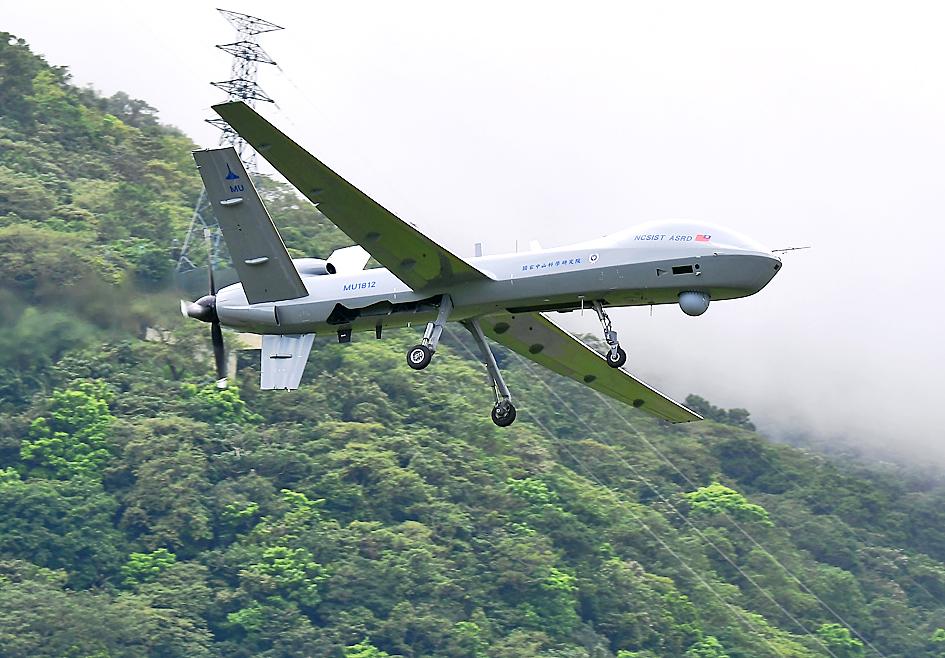The indigenous Teng Yun 2 drone showed medium and long-range flight capability, as well as guidance control over a long range, breaking an important technological barrier on its way to entering military service after its first flight over open seas, the Liberty Times (the Taipei Times’ sister newspaper) reported yesterday.
The second prototype of the tactical reconnaissance and combat drone this month conducted a series of test flights from the Chiashan Air Force Base in Hualien County.
Developed by the Chungshan Institute of Science and Technology, the Teng Yun 2, or “Cloud Rider” (騰雲二型), is a tactical uncrewed combat aerial vehicle (UCAV) designed to complement the four MQ-9B strategic drones that Taiwan’s military acquired from the US.

Photo: Yu Tai-lang, Taipei Times
The flight clearly showed the trajectory of the UCAV over nearly three hours, it said.
UCAVs have been receiving increased attention for their role in the Russia-Ukraine war, as their reconnaissance and combat abilities have granted Ukraine’s military an unforeseen advantage.
The institute has created four Teng Yun drones, two of which were developed in 2016.
Research began in 2018 on a prototype for an updated craft, which uses engines purchased from the US.
After one of the first-generation drones on Feb. 18 crash-landed in Taitung Forest Park, testing was moved to the more secure Chiashan Base for security reasons.
Defense International magazine news editor Chen Kuo-ming (陳國銘) said that due to safety reasons and limited capabilities, test flights over the ocean were previously conducted near the coast.
Testing a drone further out to sea is extremely risky, especially for as long as three hours, Chen said, adding that all communications systems must work flawlessly.
In addition to range, the institute was also testing a wide and complex array of optical sensors, radar and other systems, he said.
Hopefully, all of the technological barriers would be broken so the drone could enter service as soon as possible, he said.

Taiwan is to commence mass production of the Tien Kung (天弓, “Sky Bow”) III, IV and V missiles by the second quarter of this year if the legislature approves the government’s NT$1.25 trillion (US$39.78 billion) special defense budget, an official said yesterday. Commenting on condition of anonymity, a defense official with knowledge of the matter said that the advanced systems are expected to provide crucial capabilities against ballistic and cruise missiles for the proposed “T-Dome,” an advanced, multi-layered air defense network. The Tien Kung III is an air defense missile with a maximum interception altitude of 35km. The Tien Kung IV and V

The disruption of 941 flights in and out of Taiwan due to China’s large-scale military exercises was no accident, but rather the result of a “quasi-blockade” used to simulate creating the air and sea routes needed for an amphibious landing, a military expert said. The disruptions occurred on Tuesday and lasted about 10 hours as China conducted live-fire drills in the Taiwan Strait. The Civil Aviation Administration (CAA) said the exercises affected 857 international flights and 84 domestic flights, affecting more than 100,000 travelers. Su Tzu-yun (蘇紫雲), a research fellow at the government-sponsored Institute for National Defense and Security Research, said the air

A strong continental cold air mass is to bring pollutants to Taiwan from tomorrow, the Ministry of Environment said today, as it issued an “orange” air quality alert for most of the country. All of Taiwan except for Hualien and Taitung counties is to be under an “orange” air quality alert tomorrow, indicating air quality that is unhealthy for sensitive groups. In China, areas from Shandong to Shanghai have been enveloped in haze since Saturday, the ministry said in a news release. Yesterday, hourly concentrations of PM2.5 in these areas ranged from 65 to 160 micrograms per cubic meter (mg/m³), and pollutants were

Taiwan’s armed forces have established response protocols for a wide range of sudden contingencies, including the “Wan Chun Plan” to protect the head of state, the Ministry of Defense (MND) said today. After US President Donald Trump on Saturday launched a series of airstrikes in Venezuela and kidnapped Venezuelan President Nicolas Maduro, concerns have been raised as to whether China would launch a similar “decapitation strike” on Taiwan. The armed forces regularly coordinate with relevant agencies and practice drills to ensure preparedness for a wide range of scenarios, Vice Minister of National Defense Hsu Szu-chien (徐斯儉) told reporters before a